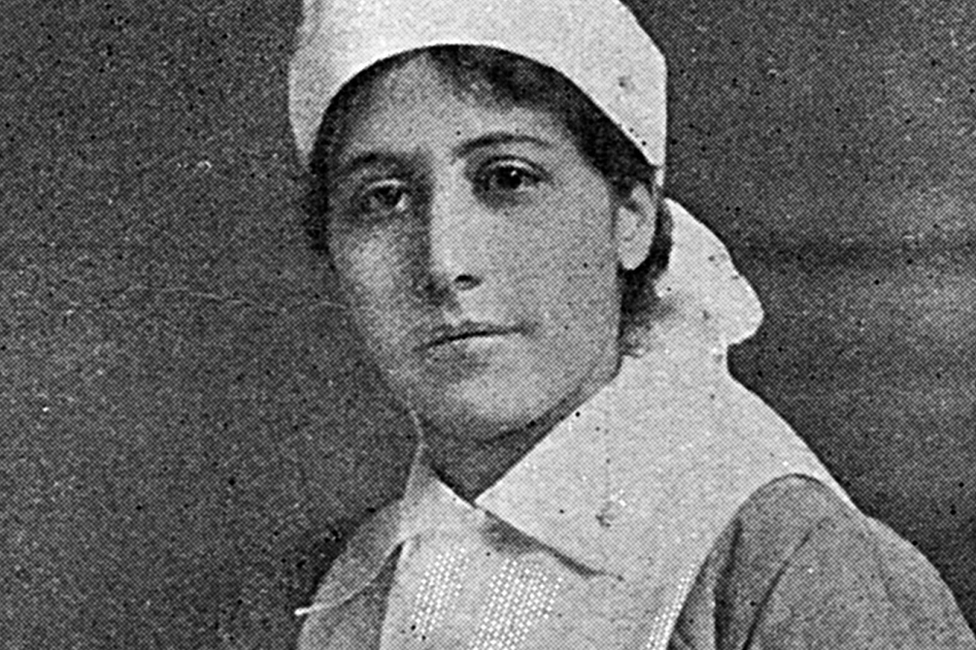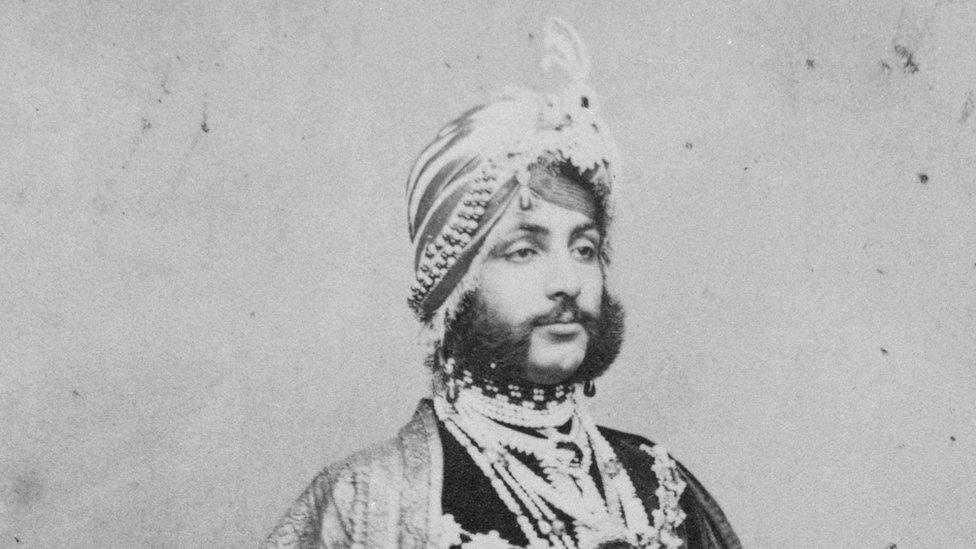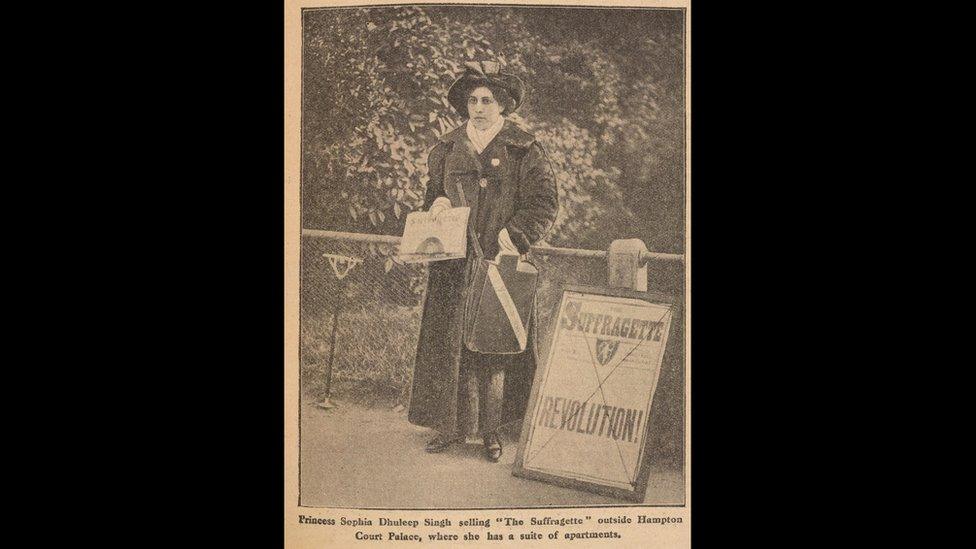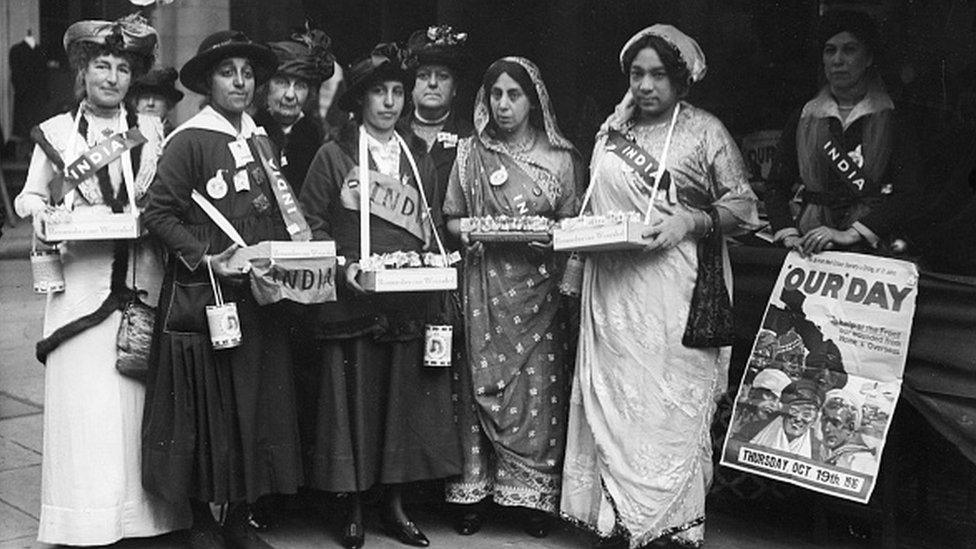Sophia Duleep Singh: Indian princess who fought for women to vote in UK
- Published

Sophia Duleep Singh was born in 1876
Sophia Duleep Singh, a princess who fought for women's voting rights in the UK, remains a little-known figure in India, the country of her ancestry.
In 1910, she was part of a delegation of 300 suffragettes who marched towards the parliament in London, seeking an audience with then Prime Minister HH Asquith.
But Asquith refused to meet the women and the demonstration turned violent as policemen and men in the crowd outside the building beat them. Many of the demonstrators were seriously injured and the day came to be called Black Friday, external in the UK.
Sophia was among the 119 women who were arrested.
She was the daughter of Maharaja Sir Duleep Singh - the last Sikh emperor of Punjab - and a goddaughter of Queen Victoria.
"Sophia Duleep Singh was as close to a celebrity as you could get in November 1910 when she took part in Black Friday," her biographer Anita Anand said in an interview, external.
Much of what is now known of her comes from Anand's in-depth 2015 biography, Sophia: Princess, Suffragette, Revolutionary, pieced together from detailed archival research, police and intelligence records and first-hand accounts from people who knew her.
Born in 1876, Sophia was the fifth of the six children Duleep Singh had with his first wife Bamba Müller.
As a boy, Duleep Singh had been exiled to England from India after his kingdom was annexed by the British in 1849, with the priceless Koh-i-Noor diamond handed to them under the terms of a punitive treaty.

Duleep Singh was the last Sikh emperor of Punjab before it was annexed by the British
Sophia grew up in the family's home in Suffolk but had a tumultuous childhood, Anand writes. Duleep Singh was exiled to France in 1886 after failed attempts to reclaim his throne, and abandoned his family to debt.
But the family's close relationship with Queen Victoria helped them secure a home and yearly allowance from the India Office, a department of the British government.
When Sophia grew up, she was given a grace-and-favour apartment by the queen in the Hampton Court Palace, outside which she would later go on to protest for the right to vote.
"From an early age, [Sophia] learned to negotiate between the easy existence granted to her as a member of Britain's elite and her ambiguous position as an Indian woman living in Britain during the heyday of the British Empire," historian Elizabeth Baker writes in a chapter in the book The British Women's Suffrage Campaign.
Over her lifetime, Sophia made about four visits to India, each of them closely monitored by British officials who feared that the presence of Duleep Singh's family would foment dissent.
In 1906-07, Sophia met freedom fighters Gopal Krishna Gokhale and Lala Lajpat Rai in Lahore (now in Pakistan) and was moved by their speeches and political conviction.
"By April 1907, Sophia had spent six months in India and had witnessed firsthand the growing political turbulence in India. The push for Indian self-determination had seduced her," Anand writes in her book.
In 1908, a few months after returning to the UK, Sophia joined the Women's Social and Political Union (WSPU), a suffrage group led by British political activist Emmeline Pankhurst.
She later also joined the Women's Tax Resistance League, whose slogan was "No Vote, No Tax".
Sophia participated in these movements with great vigour. In 1911, she threw herself at the prime minister's car as it was leaving Downing Street, holding a banner that said "Give women the vote!". The same year, she left her census form blank and refused to pay taxes.
A photo from 1913 shows the princess standing outside the Hampton Court Palace where she lived, selling copies of The Suffragette newspaper next to a board that read "Revolution!".
The photograph made her "the face of 'Suffragette Week', an initiative concocted by the WSPU to recruit more members and inundate Britain", Baker writes.

A 1913 photo showed the princess selling copies of The Suffragette newspaper
Newspapers reported, external on how authorities seized and auctioned her jewels for failing to pay certain taxes. Sophia was arrested several times but unlike other suffragettes, charges against her were always dropped.
In the book South Asian Resistances in Britain, 1858 - 1947, historian Sumita Mukherjee pointed to Sophia's involvement to highlight the contradictions in the suffragette movement - that they could capitalise on her title for their cause without interrogating or challenging class hierarchies.
Her presence also drew more scrutiny.
"India Office bureaucrats collected press clippings and swapped memoranda regarding her personal and financial affairs in an effort to control Duleep Singh's actions as a politicised member of the Indian diaspora in Britain," Baker writes.
She calls Sophia "an important bridge between Indian activists and white British activists for female suffrage".
In 1918, the British Parliament passed a reform that allowed women over the age of 30 to vote if they met certain qualifications regarding property. Equal franchise would come 10 years later.
In 1919, Sophia accompanied, external political activists Sarojini Naidu and Annie Besant to the India Office in London. Naidu and Besant led a delegation of Indian women to lay out their arguments for the right to vote before the Secretary of State. He heard them out but made no promises (Indians got universal franchise after the country became independent).
The spotlight on Sophia particularly annoyed King George V who was "anti-suffrage", Anand writes in her book. But there was little he could do as "Parliament held ultimate control" over her finances.
Sophia was involved in other causes too - during World War I, she helped tend to wounded Indian soldiers in Britain and raised money for them.

During World War I, Sophia (second from left in the front row) was involved in raising funds for wounded Indian soldiers
According to Anand's book, the princess returned to India for another visit in 1924, determined to travel across Punjab.
As she traversed the old Sikh kingdom with her sister Bamba, crowds thronged to see them, with some crying, "Our princesses are here!"
Among the places they visited was the site of the 1919 Jallianwala massacre where hundreds of Indians were shot by British troops.
During World War Two, she left London for Buckinghamshire along with her sister Catherine and three evacuees from London.
Her last years were spent with her companion and housekeeper Janet Ivy Bowden, whose daughter Drovna was Sophia's goddaughter.
Drovna told Anand that the princess would talk to her often about the importance of voting.
"She would say '...When you are allowed to vote you are never, ever to fail to do so. You don't realise how far we've come,'" Drovna recounts.
Sophia died in her sleep on 22 August 1948 at the age of 71.
As per the princess's wishes, her ashes were brought to Lahore by her sister Bamba but it is not clear where they were scattered.
But she is still fondly remembered by many, especially in the UK - a plaque honouring her was unveiled at her former home earlier this year and a film about her is expected to be released next year.
BBC News India is now on YouTube. Click here, external to subscribe and watch our documentaries, explainers and features.

Read more India stories from the BBC:
